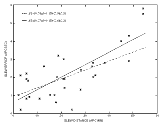



Next: 3.7 Moving Targets
Up: 3 Pre-Observation Preparations
Previous: 3.5 Finding Charts
After a long slew, identification of a faint target can be difficult or even
impossible. An offset maneuver to your target from a relatively bright nearby
star with accurate coordinates will generally be necessary. Possible reasons
for using an offset maneuver are to observe objects which are too faint to be
detected by the FES, save time in locating targets which are marginally
detectable in the FES, observe precise locations in diffuse sources,
observe targets with close companions, or locate some classes of moving
targets.
For arc-second maneuver accuracy, the distance from the offset star to the
target should be less than 0.25 degrees, ideally only a few arc minutes. A plot
of offset maneuver accuracy as a function of total slew length is shown in
Figure 3.2. If accurate 1950 right ascension and declination, corrected for
proper motion, for both the target and offset star are used for calculating the
offset maneuver, and if the offset slew distance is less than 15 arc minutes,
then the slew should place the target within two arc seconds of the reference
point. (The offset star is centered at the FES reference point before the offset
slew.)
 Figure 3.2: Blind offset maneuver
accuracy. The total slew error in arc seconds is shown as a function of the
offset distance in arc minutes. The data is taken from Arquilla (1990). The recommended maximum offset
distance to insure a total slew error of no more than 2.0 arc seconds is 15
arc minutes.
Figure 3.2: Blind offset maneuver
accuracy. The total slew error in arc seconds is shown as a function of the
offset distance in arc minutes. The data is taken from Arquilla (1990). The recommended maximum offset
distance to insure a total slew error of no more than 2.0 arc seconds is 15
arc minutes.
At the normal telemetry rate of 20 Kbps, the limiting magnitude for a star in an
FES image is 12.0. At a telemetry rate of 5 Kbps, the limiting magnitude is
13.5. Such an image with the default of 10.8 arc minutes in size requires over
3 minutes of integration. Special acquisition techniques are required for
fainter objects.
One method is to command the FES, in track mode, to look at the reference point
at the end of the offset maneuver. If the target falls within the FES's track
pattern (12 arc seconds), a long integration (i.e. about one minute) is obtained
of the target's position and brightness. Using this position the target is then
centered at the reference point before maneuvering the target to the desired
aperture with standard slews. This technique can be used for point sources down
to approximately 14.0 magnitude. A second technique is to map out a
one-arc-minute-square portion of sky around the reference point. The long
integration at each pixel in this "postage stamp" FES image allows
detection
of objects as faint as 14.0 - 14.5 magnitude, depending on the sky background
brightness. From the postage stamp, small corrections in telescope pointing can
be commanded so that most of the light from the target falls on one FES pixel (8
arc seconds square) centered on the reference point. The target can then be
maneuvered to the desired aperture by the standard slews. This technique is not
as accurate as the FES tracking mode, (because of the low
spatial resolution (±4 arc seconds) in FES images), however, it can
be used for much fainter objects.
If the target is fainter than approximately 14.5 magnitude, it cannot be seen by
the FES and the acquisition must be done blindly. Since the large aperture is
only a 10 x 20 arc second oval (the small aperture is a 3 arc-second-diameter
circle), positions accurate to one arc second or better, corrected for proper
motion, are necessary for the offset star and target.




Next: 3.7 Moving Targets
Up: 3 Pre-Observation Preparations
Previous: 3.5 Finding Charts
Last updated: 23 July 1997
jrc
 Figure 3.2: Blind offset maneuver
accuracy. The total slew error in arc seconds is shown as a function of the
offset distance in arc minutes. The data is taken from Arquilla (1990). The recommended maximum offset
distance to insure a total slew error of no more than 2.0 arc seconds is 15
arc minutes.
Figure 3.2: Blind offset maneuver
accuracy. The total slew error in arc seconds is shown as a function of the
offset distance in arc minutes. The data is taken from Arquilla (1990). The recommended maximum offset
distance to insure a total slew error of no more than 2.0 arc seconds is 15
arc minutes.